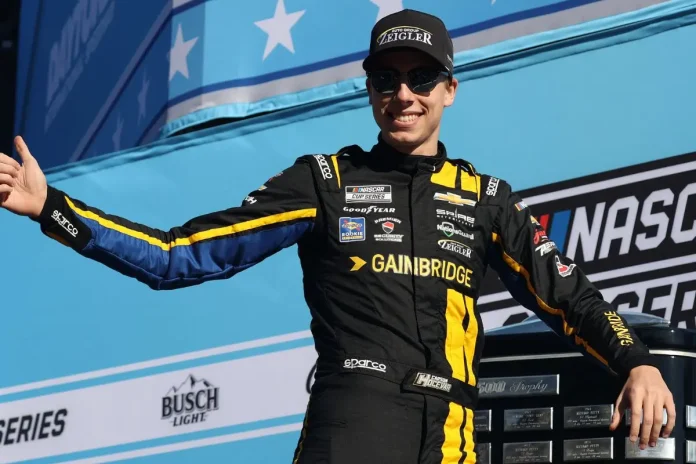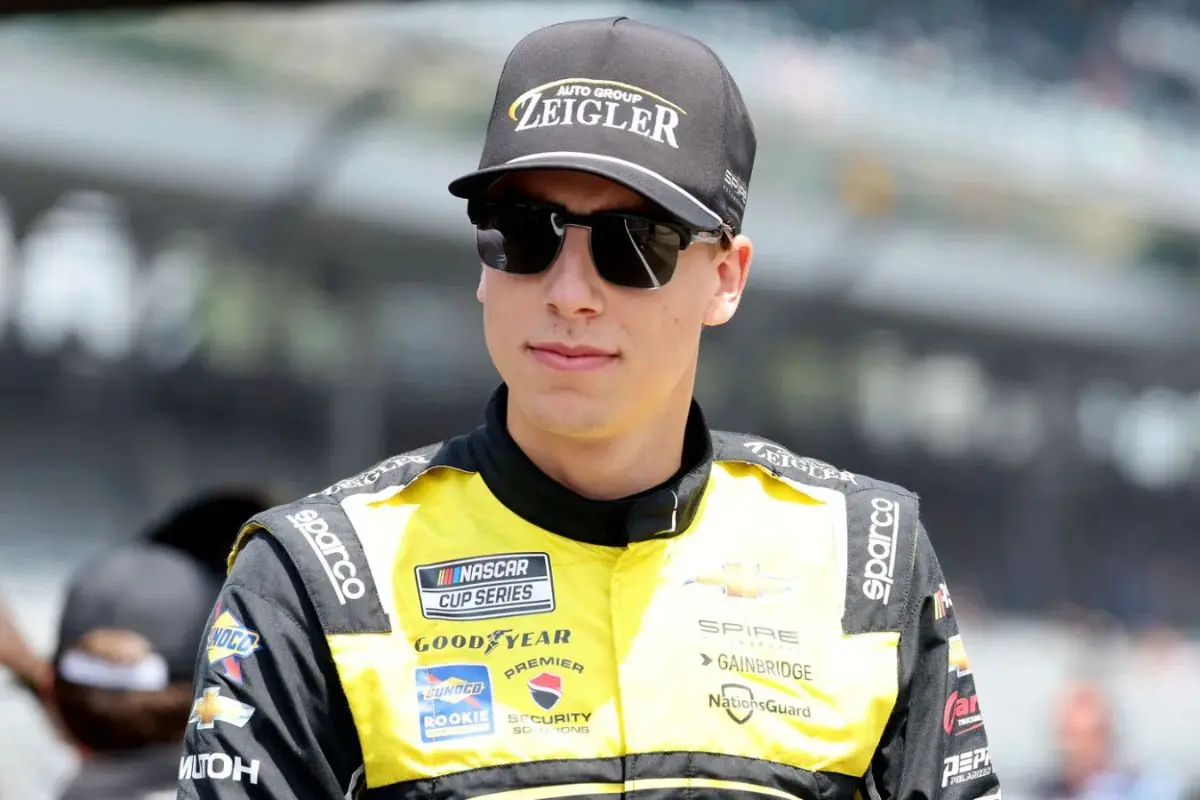Carson Hocevar’s mission to mimic NASCAR stars, such as Ross Chastain and Daniel Suárez, through meticulous simulator training. This year-long regimen emphasizes analyzing driving techniques and vehicle performance, providing him with a profound understanding of car dynamics. By skillfully translating virtual experiences into real-life racing situations, Carson Hocevar demonstrates significant adaptability and insight.
Key Highlights
- Carson Hocevar dedicated a year to simulator training, emulating driving styles of NASCAR stars like Ross Chastain and Daniel Suárez.
- His strategic simulator analysis enhanced his understanding of car dynamics, crucial for real-world racing performance.
- Hocevar aims to secure a full-time Cup seat by leveraging insights from previous teams and racing experiences.
- Continuous learning and tactical approaches are central to Hocevar’s mission for a breakthrough season in 2025.
- Fans and analysts anticipate significant improvements from his calculated methodologies and systematic enhancements on the track.
Carson Hocevar’s Rapid Rise in NASCAR
Although many aspiring drivers rely solely on raw talent and experience, Carson Hocevar’s ascent in the NASCAR Cup Series exemplifies the power of tactical preparation and deliberate practice. His progression is a demonstration to the art of calculated skill acquisition, reflecting a meticulous approach that distinguishes him from his peers.
Before stepping into a NASCAR Cup car, Hocevar dedicated an entire year to mastering the intricacies of NASCAR racing through simulator training. In this virtual environment, he immersed himself not just in the mechanics of the tracks but also in the detailed driving styles of seasoned competitors, particularly Ross Chastain. This thorough analysis allowed him to internalize the strategies and techniques that underpin successful racing, thereby equipping him with an invaluable mental toolkit.
When he made his debut, Hocevar’s ability to adapt rapidly and provide insightful feedback was immediately apparent, showcasing a level of preparedness that few rookies possess. His ascension to Rookie of the Year was no accident; it was the result of rigorous preparation and an astute understanding of racing dynamics.
Hocevar’s success in his inaugural season serves as a compelling case study for aspiring drivers, illustrating that talent alone is insufficient. Instead, it is the synthesis of practice, analysis, and mental fortitude that creates a formidable competitor in the high-stakes world of NASCAR. As Hocevar continues to navigate his career, his calculated groundwork will certainly serve as a foundational element in his pursuit of excellence on the track.
Carson Hocevar’s Simulator Training at Trackhouse Racing
The detailed art of simulator training has become a crucial component in the preparation of modern NASCAR drivers, and Carson Hocevar‘s experience with Trackhouse Racing exemplifies this trend. Prior to his foray into Cup racing, Hocevar engaged in a year-long simulator regimen that extended beyond mere lap times; it was a deep-dive exploration into the driving styles of his future teammates, Ross Chastain and Daniel Suárez.
This unique opportunity allowed Hocevar to refine his craft by emulating the subtleties of their racing techniques. Hocevar’s mission was not to set the fastest lap but to become an adept mimic of Chastain and Suárez. This analytical approach required him to closely examine what made their vehicles perform at peak efficiency, ultimately enhancing his understanding of car dynamics.
As he articulated, “My job was to match Ross Chastain and match Daniel Suárez with their driving styles and tell us what the car drives like.” This level of detail is critical in a sport where every fraction of a moment counts.
The simulator’s advanced technology enables teams to assess different vehicle adjustments without the inherent risks of on-track testing. Every variable, from tire pressure to aerodynamic tweaks, is carefully simulated, providing invaluable insights.
Carson Hocevar’s Use of Simulator Experience in Real-Life Racing
Leveraging his extensive simulator experience, Carson Hocevar has effectively translated virtual insights into tangible performance on the racetrack. This groundbreaking approach has become a cornerstone of his development, particularly during the crucial 2024 season, where he emerged as a notable talent within the Chevrolet roster. By shadowing established drivers like Ross Chastain, Hocevar gained invaluable perspectives that informed his racing strategy.
His simulator training proved particularly advantageous during the season finale at Phoenix, where the team implemented a setup derived from his simulator data. This tactical alignment allowed Hocevar to consistently navigate the top 15, showcasing the real-world applicability of his training.
A striking instance of this synergy occurred during his substitution drive for Spire Motorsports at Gateway in June 2023. Hocevar adeptly referenced his simulator experiences to calibrate his feedback, noting, “This is what the Trackhouse car felt like.” This ability to draw direct parallels between simulation and reality enabled him to propose precise car adjustments that greatly improved race-day performance.
Moreover, Hocevar’s adeptness in the simulator equipped him with a unique foresight prior to actual track time. His familiarity with the subtleties of the Cup car allowed him to articulate his needs even before completing his opening lap, a reflection of the depth of his preparation.
As he matched the performance of seasoned drivers like Chastain and Suárez in the simulator, Hocevar solidified his reputation as a driver who seamlessly integrates virtual training into his real-life racing endeavors.
Carson Hocevar’s Goal and His Rapid Ascent in the NASCAR Cup Series
Carson Hocevar’s aspirations extend far beyond merely competing in the NASCAR Cup Series; he envisions himself as a formidable presence within the championship landscape. His entry into the series marked not just another race on the calendar, but rather a tactical step toward a grander objective.
Hocevar’s ambition is palpable; he expressed a clear intent to secure a full-time Cup seat by the race’s finale, a proof of his confidence and resolve. This mindset highlights a profound understanding of the competitive nature of NASCAR, where opportunities are fleeting and must be grasped with conviction.
Hocevar’s rapid rise from part-time substitute to full-time contender emphasizes his exceptional skill set. His proficiency in simulators has provided him with a unique advantage, allowing him to master the intricacies of racing dynamics and translate that knowledge into real-world performance. This duality of experience—virtual training coupled with on-track execution—has accelerated his development, enabling him to adapt quickly to the rigors of the Cup Series.
Additionally, Hocevar’s ability to learn and adjust on the fly has positioned him as a rising star, capable of maneuvering through the complexities of racing’s elite echelon. As he continues to refine his craft and build upon his experiences, the NASCAR landscape should prepare for an athlete who is not only chasing victories but also aspiring to leave an indelible mark on the sport.
Carson Hocevar’s Expectations for 2025
Entering the 2025 NASCAR season, Hocevar is poised to improve his performance expectations as he aligns himself with a burgeoning organization. This significant year marks a critical turning point in his career, leading him to accept the demands that accompany heightened ambitions.
In discussions with Jeff Gluck, Hocevar articulates a pragmatic approach to success, emphasizing the importance of leveraging past experiences rather than succumbing to the weight of expectations.
“It’s going to be the mix of taking what Travis Peterson at Front Row, what Rodney Childers at Stewart-Haas, and what we did at Spire.” – Carson Hocevar
Hocevar’s strategy hinges on synthesizing insights garnered from his time at Front Row Motorsports, Stewart-Haas Racing, and Spire Motorsports. He asserts that the quest for improvement is not about reinventing the wheel but rather about refining existing methodologies.
“We’re looking for a tenth or a half-tenth of a moment,” he explains, highlighting the competitive nature of today’s NASCAR landscape where marginal gains can translate into considerable positional advantages.
The era of shortcuts, such as unconventional body designs or secret chassis modifications, has waned. Instead, Hocevar recognizes that success is rooted in systematic, incremental enhancements.
This complex understanding of performance optimization positions him distinctly for the 2025 season, as he aims for consistent improvement rather than radical transformations.
As Hocevar initiates this important season, his commitment to meticulous detail and tactical application of learned lessons will be essential.
News in Brief: Carson Hocevar’s Mission to Mimic NASCAR Stars
Carson Hocevar’s tactical approach to emulate NASCAR stars through advanced simulator training demonstrates a notable evolution in competitive racing techniques. This groundbreaking methodology not only improves driving skills but also fosters a deeper understanding of race dynamics.
As Hocevar continues to ascend within the Cup Series, expectations for future performances remain high. The fusion of simulation technology with real-world racing highlights the revolutionary potential of such practices, paving the way for the next generation of NASCAR competitors.
ALSO READ: Corey LaJoie’s NASCAR Career Crumbles as Carson Hocevar Outshines Him in Every Way





